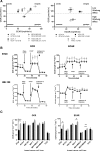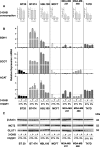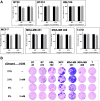Beta-hydroxybutyrate (3-OHB) can influence the energetic phenotype of breast cancer cells, but does not impact their proliferation and the response to chemotherapy or radiation
- PMID: 29942509
- PMCID: PMC5996481
- DOI: 10.1186/s40170-018-0180-9
Beta-hydroxybutyrate (3-OHB) can influence the energetic phenotype of breast cancer cells, but does not impact their proliferation and the response to chemotherapy or radiation
Abstract
Background: Ketogenic diets (KDs) or short-term fasting are popular trends amongst supportive approaches for cancer patients. Beta-hydroxybutyrate (3-OHB) is the main physiological ketone body, whose concentration can reach plasma levels of 2-6 mM during KDs or fasting. The impact of 3-OHB on the biology of tumor cells described so far is contradictory. Therefore, we investigated the effect of a physiological concentration of 3 mM 3-OHB on metabolism, proliferation, and viability of breast cancer (BC) cells in vitro.
Methods: Seven different human BC cell lines (BT20, BT474, HBL100, MCF-7, MDA-MB 231, MDA-MB 468, and T47D) were cultured in medium with 5 mM glucose in the presence of 3 mM 3-OHB at mild hypoxia (5% oxygen) or normoxia (21% oxygen). Metabolic profiling was performed by quantification of the turnover of glucose, lactate, and 3-OHB and by Seahorse metabolic flux analysis. Expression of key enzymes of ketolysis as well as the main monocarboxylic acid transporter MCT2 and the glucose-transporter GLUT1 was analyzed by RT-qPCR and Western blotting. The effect of 3-OHB on short- and long-term cell proliferation as well as chemo- and radiosensitivity were also analyzed.
Results: 3-OHB significantly changed the oxygen consumption rate (OCR) and extracellular acidification rate (ECAR) in BT20 cells resulting in a more oxidative energetic phenotype. MCF-7 and MDA-MB 468 cells had increased ECAR only in response to 3-OHB, while the other three cell types remained uninfluenced. All cells expressed MCT2 and GLUT1, thus being able to uptake the metabolites. The consumption of 3-OHB was not strongly linked to mRNA overexpression of key enzymes of ketolysis and did not correlate with lactate production and glucose consumption. Neither 3-OHB nor acetoacetate did interfere with proliferation. Further, 3-OHB incubation did not modify the response of the tested BC cell lines to chemotherapy or radiation.
Conclusions: We found that a physiological level of 3-OHB can change the energetic profile of some BC cell lines. However, 3-OHB failed to influence different biologic processes in these cells, e.g., cell proliferation and the response to common breast cancer chemotherapy and radiotherapy. Thus, we have no evidence that 3-OHB generally influences the biology of breast cancer cells in vitro.
Keywords: Breast cancer; Chemotherapy; Ionizing radiation; Ketogenic diet; Ketone bodies; Metabolic profile; Seahorse; β-Hydroxybutyrate.
Conflict of interest statement
Not applicableThe authors declare that they have no competing interests.Springer Nature remains neutral with regard to jurisdictional claims in published maps and institutional affiliations.
Figures






References
LinkOut - more resources
Full Text Sources
Other Literature Sources
Miscellaneous

